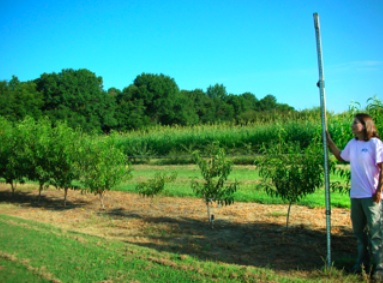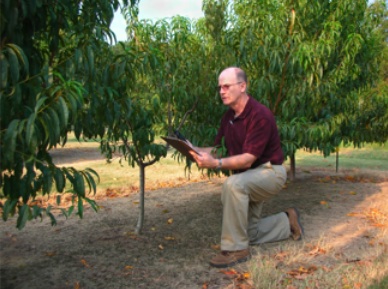
 NEWS HIGHLIGHT
NEWS HIGHLIGHT
Tall fescue helps protect peach trees
Planting tall fescue grass as a ground cover in peach orchards helps
protect peach trees from nematodes that attack tree roots, according to U.S. Department of Agriculture
(USDA) scientists.
November
29, 2011 – Planting tall fescue grass as a ground cover in peach orchards helps
protect peach trees from nematodes that attack tree roots, according to U.S. Department of Agriculture
(USDA) scientists.
In a
study published in the Journal of Nematology in
2010, Agricultural Research Service
(ARS) plant pathologists Andy Nyczepir at the Southeastern Fruit and Tree Nut Research
Laboratory in Byron, Ga., and Susan Meyer at the Nematology Laboratory in
Beltsville, Md., tested several tall fescue varieties to find out if they could
thwart four troublesome root-knot nematode species: Meloidogyne incognita, M.
hapla, M. javanica, and M. arenaria.
 |
|
| Some tall fescues, planted and established as a groundcover before peach tree planting, can promote growth of the trees by suppressing reproduction of some species of root-knot nematodes. Here, technician Merry Bacon holds a ruler to show that trees on the left, planted into a stand of tall fescue 18 months earlier, are taller and fuller than trees on the right (controls, planted in unfumigated soils without tall fescue groundcover). |
In the
study, Nyczepir and Meyer found that a commercial tall fescue, MaxQ, prevented
M. incognita and M. hapla from reproducing. M. javanica has a low level of
reproduction on MaxQ, but M. arenaria can reproduce on it.
Traditionally,
growers have fumigated peach orchard soils prior to planting and then used a
nematode-resistant rootstock. But in recent years, growers have faced tough
times that have made it difficult to afford preplant fumigants, such as Telone
II or Vapam. Many growers also have difficulty fumigating at the recommended
time of year because of conflicts with managing other crops.
 |
|
|
Plant |
In
Georgia, rotation with coastal Bermuda grass, which can also be harvested for
hay, is recommended for control of root-knot nematode. According to Nyczepir,
their studies show that MaxQ may have potential as a preplant control strategy
for M. incognita and M. hapla in southeastern and northeastern areas of the
United States. Using this tall fescue as a preplant cover crop treatment may
allow growers to reduce the use of chemical nematicides.
Preliminary
data from the team's field trials using MaxQ as a preplant cover crop have so
far found that peach trees planted after the cover crop are larger than those
planted in soil that is not fumigated.
Read more about this research
in the November/December 2011 issue of Agricultural Research magazine.
Print this page